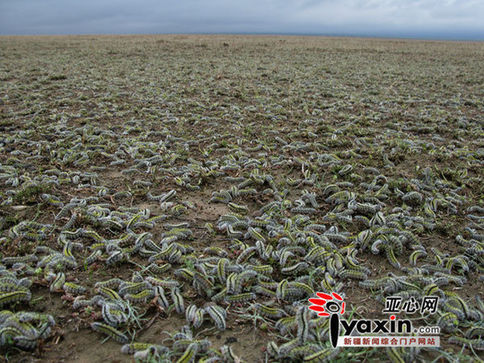About 20,000 heads of livestock and 50 families have been forced to leave a grassland due to an invasion of mysterious worms this week in Usu, Xinjiang Uygur Autonomous Region.
|

|
|
Photo taken shows an invasion of mysterious worms in Usu, Xinjiang Uygur Autonomous Region.
|
The worms, with a density of up to 3,000 per square meter, consumed the grassland, leaving only soil behind, a Xinhua correspondent said.
Zhang Xishan, an official in charge of grassland management, said on Friday that the worms have damaged 8,000 hectares of pasture land, of which 4,670 hectares were totally ruined.
"They eat grass like they are rolling a carpet," Zhang said. It was the worst plague of worms in 30 years in Usu, which is 280 kilometers west of the region's capital Urumqi.
However, local experts failed to identify the 2 centimeter-long thorny green worm with black stripes. Worm samples were sent for identification to Xinjiang Agricultural University on Friday.
"The pasture was green a week ago. But now the worms are creeping around and they even come into my house," said a herdsman named Bixian. "I have to sweep them out several times an hour."
He said he had never seen the worms before.
Xinjiang has a history of using chickens, ducks and birds to fight locusts, which are also a menace to grassland. However, these birds weren't interested in Usu's worms.
The Usu municipal government announced a grazing ban on affected grassland. The ban started yesterday and will be in force for at least one week.
Xinjiang's regional locust and rodent control headquarters sent two spray vehicles along with 5 tons of pesticide to Usu. Each vehicle was spraying pesticide on 400 to 530 hectares per day. The operation could last 12 days.
Mu Chen, a headquarters official, said the worms could be moth larvae. He said the warm winter and wet spring may have helped produce the army of worms.